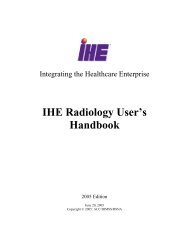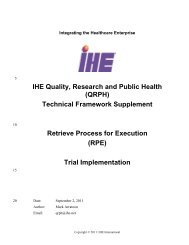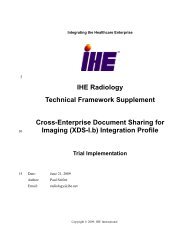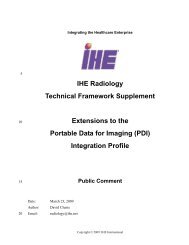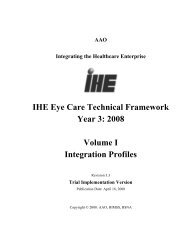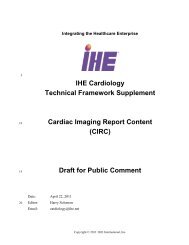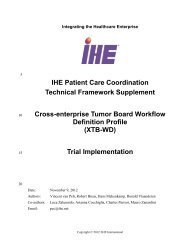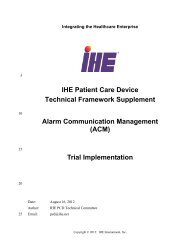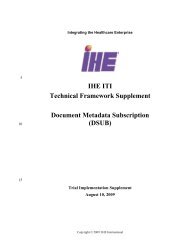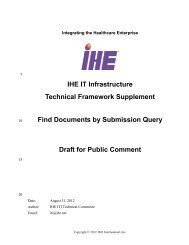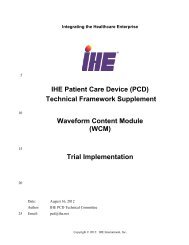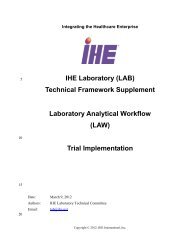IHE Patient Care Device Technical Framework
IHE Patient Care Device Technical Framework
IHE Patient Care Device Technical Framework
- No tags were found...
Create successful ePaper yourself
Turn your PDF publications into a flip-book with our unique Google optimized e-Paper software.
102030<strong>IHE</strong> <strong>Patient</strong> <strong>Care</strong> <strong>Device</strong> <strong>Technical</strong> <strong>Framework</strong>, Vol. 2: Transactions________________________________________________________________________There are many additional objects defined in the ISO/IEEE 11073 information model(e.g., waveform and alarm / alert monitoring objects); however, for the purposes of thistechnical framework, only the above objects are utilized. Each object provides thefollowing:Medical <strong>Device</strong> SystemVirtual Medical <strong>Device</strong>ChannelMetricNumericTop level object that establishes the overall contextfor all device data. In addition to a basic devicename (e.g., Ventilator), this object includesattributes for a unique identifier (e.g., ,EUI-64),manufacturer and model, subcomponent serialnumbers, device date and time, A/C power status,battery charge level, locale, etc. Note that an MDSmay contain additional MDS objects. This wouldbe the case when, for example, a physiologicalmonitor integrates additional devices such asexternal infusion pumps and ventilators. 3Supports a particular device specialization that maycontain multiple channels and reflects a basicdevice building block. For example, an airwayVMD may contain channels for pressure, flow,volume, and breath metrics. For devices with pluginmodules, each component is typically formalizedby a VMD instance.Provides for the aggregation of closely related dataobjects. For example, an infusion pump VMD maycontain multiple fluid source channels, each with itsown parameters for delivery rate, volume to beinfused (“VTBI”), volume infused, drug label, etc.This abstract class (it is only inherited by thespecialization objects and may not be instantiatedalone) provides a basic set of attributes for all thespecialization objects. For example, status (e.g.,available, disabled, etc.), body site list,measurement start/stop time, label, etc.Supports values that are represented as a numericquantity (e.g., a set breath rate). Attributes includevalue, units, time stamp, ranges, resolution, etc.specialization objects add any attribution – they only reflect the relationships between the MDS and otherobjects (namely, other MDSs, VMDs, and <strong>Patient</strong> Demographics).Rev. 1.1 TI: 2006-08-1566Copyright © 2005-2006: ACC, ACCE, HIMSS, and RSNA



